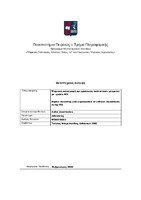Ψηφιακή καταγραφή και οργάνωση πολιτιστικών μνημείων με χρήση GIS
Digital recording and organization of cultural monuments using GIS

View/
Keywords
Γεωγραφικά Συστήματα Πληροφοριών ; ΓΣΠ ; Πολιτισμός ; Πολιτιστική κληρονομιά ; Διατήρηση πολιτιστικής κληρονομιάς ; Μνημεία ; Ανάλυση ; Βάση δεδομένων ; Geographic Information Systems ; GIS ; Culture ; Cultural heritage ; Cultural heritage conservation ; Monuments ; Analysis ; DatabaseAbstract
The rapid development of technology in recent years has marked the development of alternative techniques and innovative methods for the preservation of cultural heritage.
Now, visitors of various cultural sites, such as museums, archeological sites, galleries, etc., have the opportunity, either in real time with under physical presence or from the couch of their home, to experience the visit to such a site, to record it, evaluate it and recommend it to other visitors.
Similarly, the possibilities given by the evolution of technology, for the preservation and safeguarding of our cultural heritage are impressive. Technologies such as 3D digital modeling (BIM), virtual and augmented reality, Geographic Information Systems (GIS), artificial intelligence, and digitization of tangible and intangible cultural heritage, are used to protect and restore our cultural heritage from the numerous natural and anthropogenic dangers that threaten it, thus ensuring its passage from generation to generation.
From the above technologies, we will study in the present paper, the Geographic Information Systems (GIS), which are widely used for the recording, evaluation and preservation of cultural heritage sites.
We are aiming to examine the usefulness of GIS as a tool for recording and organizing cultural monuments, as well as analyzing and drawing conclusions that can serve as a guiding tool for policy design that will ensure their sustainable development and preservation.
The analysis will be performed on monuments of the Municipality of Athens, based on their specific attributes, such as the construction period, their initial and final use, their current condition, etc.
We will create the database with these buildings and then, with the assistance of GIS, we will extract the respective maps per study feature as well as some statistics and diagrams that will help us to draw conclusions for the study area.


